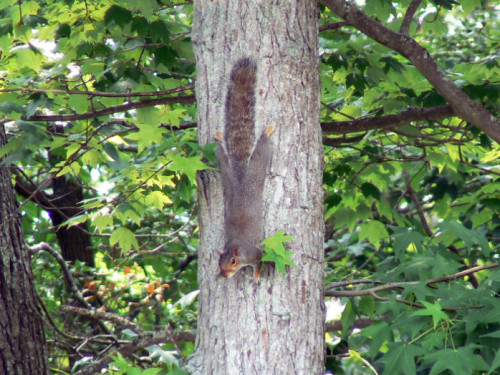Trap and relocate?
Question: We seem to have a whole new crop of squirrels that have invaded our yard and are tearing things up. We would like to trap and relocate them. Would this be permissible if they are damaging and destroying private property? (Seth, Cottonwood)
Answer: No, squirrels may not be relocated. Small nuisance mammals that are damaging property may be dispatched by the owner (as long as it is not in violation of local laws) but may not be released except in the immediate area. Relocating nuisance wildlife not only moves the problem but also places the critter into an area where it has no established shelter or food and water source, plus they may also potentially spread disease. A depredation permit, which allows for the killing of the squirrels, may be issued for tree (gray) squirrels. Another option, so that you can utilize the meat, would be to harvest the squirrels during the gray squirrel season when hunters are allowed a four-squirrel bag and possession limit.
Collection of striped shore crabs
Question: I have a question regarding Pachygrapsus crassipes, known as the striped shore crab. Is this crab legal to possess in California? If so, what’s the limit? I want to catch some of these tiny crabs for a little taste test, but I can’t seem to find any specific rules or regulations about them. (Steve Tran, Newark)
Answer: Yes, this crab is also sometimes called a “lined shore crab” and is identified by the square carapace quite easily. Since they do not have bag limits specific to their species, they default to the general invertebrate daily bag limit of 35 in possession (California Code of Regulations Title 14, section 29.05).
Archery for quail
Question: I am planning on archery hunting for quail this year. Do the same laws from shotgun apply to archery? Does the quail have to be flying before shooting at it? Or if archery hunting, can the quail be standing on the ground or sitting in the trees? (John V.)
Answer: There are early archery seasons provided for quail, so using archery equipment generally allows you to hunt both during the archery season (listed under CCR Title 14, section 300) and during the general season. Otherwise, the bag and possession limits are the same.
As far as deciding whether to shoot the birds when flying vs when they are standing on the ground or roosting in trees is not a legal question but instead an ethics decision that you must make. Under the widely accepted “fair chase” principles that most hunters abide by, shooting upland game birds or waterfowl under conditions other than when they are flying violate this widely accepted fair chase code of ethics. Archery hunters are often viewed as having accepted an even higher level of fair chase principles due to the vastly greater challenge to successfully take game via archery (at least for most of us!), compared to firearm. However, the decision to take a game bird on the ground vs. in the air remains a decision you must make on your own, regardless of your chosen method of take.
Depredation permit
Question: If I have a pig depredation permit, can I legally carry a firearm and a bow while hunting deer during the archery season? Does the person who helps me with my pig problem need a hunting license? Also, is there an expiration date on a depredation permit? I can’t seem to locate one. (Bill)
Answer: No, while deer hunting during an archery season, you may not possess a firearm of any kind.
If you are listed as one of three allowed designated shooters on a pig depredation permit, you may remove property damaging wild pigs under conditions listed on the permit. Someone “assisting you” with the depredation permit should also be listed as a designated shooter. No hunting license is required for a person authorized under a depredation permit. The person assisting you must be at least 21 years old and may not have a conviction of wildlife law in the past 12 months.
All depredation permits have an expiration date listed on them. If you can’t find it, please contact the issuing agent for assistance.
California Outdoors is a column published by the California Department of Fish and Wildlife to answer your questions about California’s many fish and wildlife species, hunting and fishing methods, regulations and opportunities and natural resource conservation. If you have a question you would like to see answered in the California Outdoors Q and A column, email it to CalOutdoors@wildlife.ca.gov.





